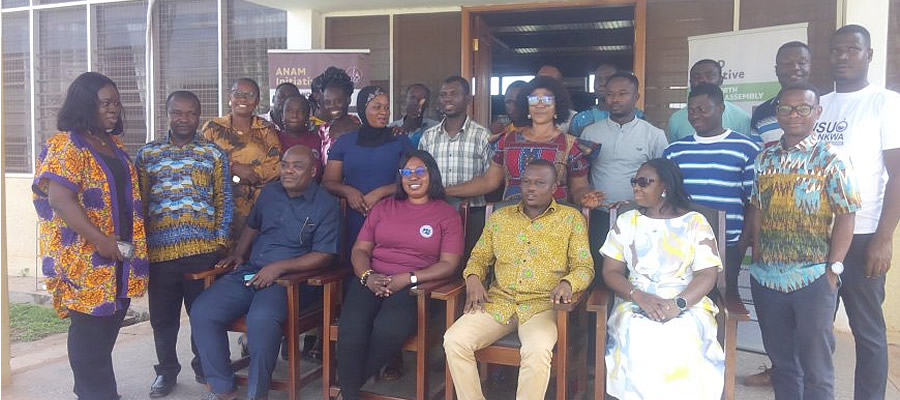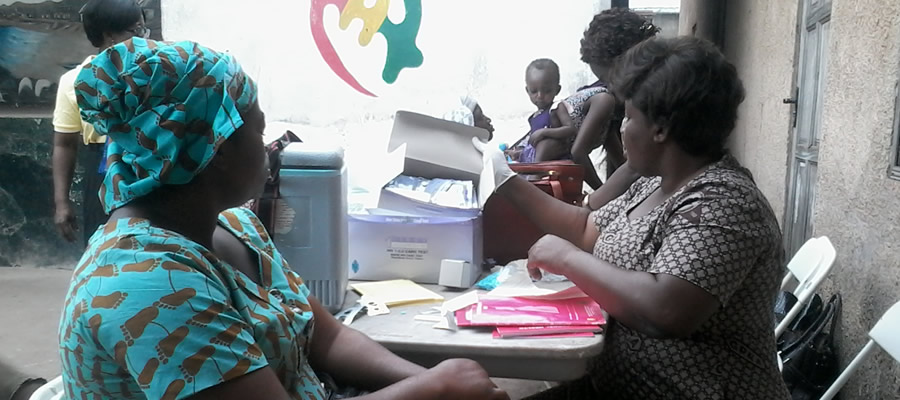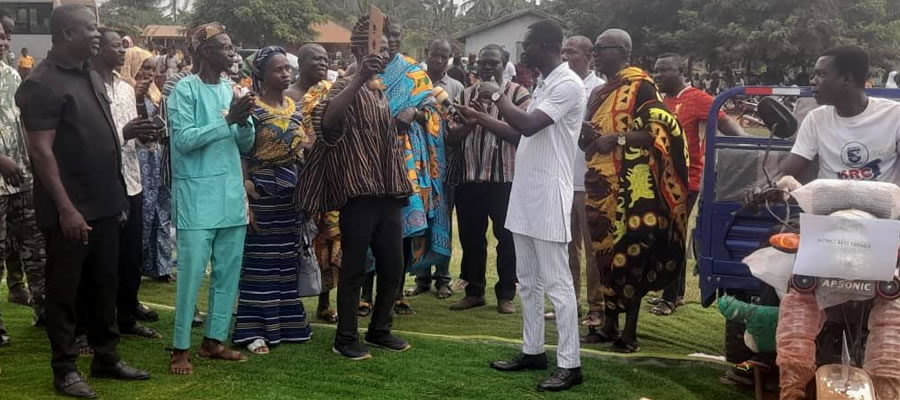

List of projects
Issues on on-going projects
Information gathered indicates that most projects and programme in the district are funded by the scarce District Assemblies Common Fund. And given the enormous needs and aspirations of the communities in the district, the over reliance on the DACF is unsustainable.
It would, therefore, be important for the Assembly to be proactive in seeking support from Business enterprises, Local and International NGOs as well as bilateral development agencies. Currently, there are a number of on-going projects with external support. Some of the funding sources in the district at the moment include; Action Aid Ghana, IDA, DFID, GET FUND, HIPC, MSHAP funds for HIV/AIDS activities, CBRDP Fund, Ghana School Feeding Programme Fund, Newmont Ghana Gold and District Assemblies Common fund (DACF). These constitute opportunities for development in the district.
The following projects were under execution at the time of preparing the District Medium Term Development Plan-2006-2009.
Goals and Objectives
District Development Goals and Objectives
This part of the Plan presents a statement of District goal linked to the Growth and Poverty Reduction Strategy (GPRS II) which is the framework for Ghana’s development for the next Four-Years.
National Development Focus
In its quest to accelerate the growth of the economy and to achieve a per capita income of $700 by the year 2009 the Government of Ghana laid a solid foundation through the implementation of Ghana Poverty Reduction Strategy (GPRS I). Proposals under GPRS II have been guided by lessons and experiences drawn from the implementation of programmes of GPRS I (2003 – 2005). Whereas the GPRS I emphasized poverty reduction programmes and projects, the GPRS II place emphasis on wealth creation and poverty reduction through growth related policies and programmes.
The basic goal of GPRS II is to “achieve accelerated and sustainable shared growth, poverty reduction and promotion of gender equity, protection and empowerment of the vulnerable and excluded within a decentralized democratic environment”. The broad strategic direction for GPRS II focuses on:
- Priorities for Private Sector Competitiveness
- Human Resource Development
- Good Governance and Civic Responsibility
This District Medium-Term Development also focuses on the broad strategic direction of GPRS II as indicated above.
District Development Goals, Objectives and Strategies
The formulation of Development focus in the planning process illustrates the areas the District Assembly would intensively concentrate its efforts and resources within the priorities and prospects for development. It serves as a link between the problems identified and the plan formulation stages. The goals give the broad statement of intent. It indicates the direction of the planned intervention in solving the identified development problems of a district in achieving its development priorities. Such an intervention needs to be comprehensive, broad-based, integrative as well as effective. This would therefore depend on our knowledge, understanding and appreciation of the existing development problems, potentials, opportunities, constraints and challenges.
District Development Goal
The development goals for the district in relation to the development focus are as follows:
Overall goal: To improve livelihoods in the district through increased citizenry participation, Public-private sector partnership, food security and employment generation activities.
Education
To increase literacy level through improved quality of education
Health
To improve the quality of health service and make health care accessible and affordable in the district
Agriculture
To increase agricultural productivity and facilitate marketing linkages
Water
To improve access to water and sanitation facilities Good Governance: To improve citizenry participation in local governance
District Development Objectives
The District’s development objectives agreed on at stakeholder’s forum include the following:
Private Sector Competitiveness
- To promote production, processing and marketing of agricultural produce in the district
- To promote rural enterprise and private sector development in the district
Human Resource Development
- To improve the quality of education at the basic and SSS level by 2009
- To improve the quality healthcare delivery in the district by 2009
- To improve basic infrastructure development in the district
- To control further spread of HIV and support PLWHAs in the district.
- To Encourage proper environmental conditions
Good Governance and Civic Responsibility
- To improve the Internally Generated Revenue and management of Financial Resources in the district
- To deepen decentralization by strengthening the DA /Sub-structures to enhance participation
- To facilitate Responsible mining in the district
District Development Themes
As a follow-up to the development goals and objectives outlined above for the District, the following development themes are formulated for the district. These themes take into consideration the themes provided in Growth and Poverty Reduction Strategy (GPRS II) which sought to reinforce and accelerate the gains made during the implementation of the GPRS I. The priority areas are, Private Sector Competitiveness, Human Resource Development and Good Governance and Civic Responsibility.
The development programmes of the district include:-
- Agriculture and rural development programmes;
- Educational Performance Improvement Programmes
- Skills and Entrepreneurial Development Programmes
Youth and Unemployed
- Sanitation Improvement Programmes
- Revenue Mobilization and Financial Management Improvement
Programmes
- Health delivery and access improvement programmes
- Programmes to promote Good Governance and community/private sector participation;
- Institutional Capacity Building Programmes;
- Supporting Programmes for the Physically Challenged;
- Processing and market linkages
- Management Information Systems Development Programmes
- HIV/AIDS Programmes
- Responsible mining activities
- Programmes and activities to avoid duplication of programmes and efficient use of resources
District Development Strategies
Important stages needed for the transformation of the district economy to the one anticipated through the above development programmes include:-
Agriculture and Rural Development Improvement Programmes
- Vigorously encouraging and supporting agro-industries targeted at both the domestic and external markets
- Creating an enabling environment for improved private sector production by improving the capacity of the private sector to adopt a business –minded approach to increase productivity and generate employment
- Reduce post-harvest losses
- improving access to portable drinking water for key urban areas and other communities
- development of strong linkages between agricultural sector and an efficient, technically progressive and market-oriented private sector;
Educational Performance Improvement Programmes
- Provision of educational infrastructure in a collaborative and efficient manner.
- provision of adequate textbooks, exercise books and trained teachers
- intensifying supervision through the provision of adequate logistics to circuit supervisors and incentive to teachers in deprived communities
- Upgrading of one senior secondary/Technical school to a better standard to meet current demands.
- Increase collaboration among the Formal and Informal education sectors
Skills and Entrepreneurial Development Programmes for the Youth and the Unemployed
- exploring opportunities for the creation of productive employment
- Strengthening the BAC and Learning centre to support SMEs
- Establishing skills acquisition centers in the form of Learning center
- Facilitate the strengthening of Civic Unions
HIV/AIDS Programmes
- intensifying the campaign on HIV/Aids related issues
- Undertake programmes to reduce stigmatization of PLWH
- providing adequate care and support for people living with AIDS
Health and Population Management Programme
- Ensuring adequate access to good drinking water for all communities
- Provision of adequate health facilities for the people
- Intensifying campaign on the mutual health insurance scheme
- Up-grade existing Health facilities to meet current health demands
- Establish Adolescent Sexual Reproductive centre
Sanitation Improvement Programmes
- Provide sustained final Waste Disposal Sites
- Ensuring sound sanitary conditions and safe disposal of waste in all settlements
- Provision of adequate places of convenience for most of the settlements
- Strengthening the Environmental health unit to play its role properly.
Programmes for the physically challenged
- Mainstreaming their activities in all programmes of the Assembly
- Diffusing the idea that such people are beggars and are to be spoon fed
- Assisting them to acquire vocational skills
- Support the Physically challenged to be productive
Emergency Relief Programme
- Designing special programmes to prevent the occurrence of natural disasters and bushfires in the district
- Encourage the establishment of Woodlots
Programme to promote good governance and community/private sector participation
- Support the sub-structures and ensure that they function
- Ensuring the establishment of all the district departments
- Provide avenue for easy access to information
- Provide a platform for private sector to dialogue with the public sector
Institutional Capacity Building Programmes
- Constructing staff quarters to attract and retain staff
- Provide enough office accommodation to take care of all Decentralized departments
- Training the staff of the Sub-structure and District Assembly to ensure effective work
Financial Management Improvement Programme
- Ensuring transparency in all activities of the Assembly
- Expanding the revenue base of the Assembly
- Put in place mechanism to reduce tax evasion
- Put in place management Control systems to ensure efficiency
Management Information Development Programme
- Establish a comprehensive data base for planning and Budgeting
- Making available all relevant information to all stakeholders as and when they are needed
Development Programmes
District Development Programmes and Indicative Financial Plan
Introduction
This chapter focuses on the District’s set of programmes and projects for the achievement of the goal and objectives as well as the location, indicators, time schedules, indicative budgets and implementing agencies (lead and collaborating) and the role they are expected to perform. These sets of programmes and projects may include all on-going activities in the GSGDA I 2010-2013. These activities are being rolled over to the new plan because they are still on-going and cannot be expunged from the plan.
The successful implementation of the listed programmes and projects depends on the availability of resources, the efficient mobilisation as well as the judicious use of the resources. This section covers the identifiable sources of resources both internal and external in relation to a set of programmes and projects to be implemented under the various thematic areas and indicative financial plan for the GSGDA II (2014-2017).
Indicative Financial Plan
This section deals with the strategies to be adopted to mobilise and utilise financial resources that are going to be used to implement activities and programmes. It mainly focuses on the cost of Medium Term Development Policy Framework using the cost of inputs.
These strategies for funds mobilisation takes into consideration sources of funding including Internally Generated Funds, projected Central Government inflows such as HIPC and District Development Fund, District Assemblies Common Fund, as well as inflows regarding planned programmes of development partners.
Most of the projects in the plan would be funded mainly from the Assembly’s share of Common Fund and the newly introduced District Development Fund (DDF) which is based on functional and organisational assessment of the District Assemblies in Ghana.
Estimated Cost of the DMTDP (2014-2017)
The estimated cost of the entire District Medium Term Development Plan (2014-2017) is GH¢13,862,015.43 and it is expected to be financed from two major sources. Out of the total cost, GH¢3,767,500 will be financed from the Internally Generated Funds (IGF) whilst the remaining GH¢10,094,515.43 will be financed from external sources which includes DACF and others. Detail of the costing of the MTDP (2014-2017) is represented in table 4.2.
Estimated Revenue to Finance the MTDP (2014-2017)
The success of plan implementation depends highly on the ability to finance it. For a plan to be effective, its finance should have a reliable source. Most Plans have failed to be executed and remained blueprint due to lack of finance resulting from weak and inefficient revenue mobilisation strategies.
However, the District’s revenue sources both internal and external should be revised to ensure effective and efficient execution of the plan. The other external source of revenue is royalties from timber and mineral concessions. On the other hand, the District Development Facility (DDF) which is also external has emerged and benefited the District.
Strategies to Mobilise Additional Resources
The following strategies may be considered:
A. Internal Source
1. Broadening our local revenue base
2. Training and motivating our revenue collectors
3. Enforcement of our bye-laws against defaulters
4. Revaluation of properties
B. External Source
1. Soliciting assistance from development partners
2. Creating an enabling environment to attract private sector investments
3. Soliciting for assistance from Non-Governmental Organisations
4. Encouraging Traditional Authorities to solicit for external assistance
5. Traditional Authorities making their jurisdictions more attractive for investments
Expenditure Areas
Resource will be strictly applied to programmes and projects that are spelt out in the Annual Action Plans under the seven thematic areas of the DMTDP (GSGDAII, 2014-2017) namely;
A. Ensuring and Sustaining of Macroeconomic Stability
B. Infrastructure and Human Settlements Development
C. Accelerating Agriculture Modernisation and Natural Resource Management
D. Enhanced Competitiveness of Ghana’s Private Sector
E. Human Development, Employment and Productivity
F. Transparent and Accountable Governance
G. Oil and Gas Development
Expenditure Control Mechanisms
The following tools would be employed to reduce the rate of waste of scarce resources;
1. Proper records keeping
2. Prompt and regular expenditure reports
3. Monitor strictly the use of Internally Generated Funds (IGF)
4. Compliance with all Financial Regulations and guidelines
Development Projections
Development Projections for 2014-2017 Based on the Ghana Shared Growth and Development Agenda (GSGDA II)
The Asutifi North District Assembly is preparing her plan based on the clear-cut guidelines of the 2014-2017 Medium Term Development Policy Framework under Ghana Shared Growth and Development Agenda (GSDAII). The District has prioritised her needs under the seven (7) thematic areas of the Medium Term Development Policy Framework of 2014-2017 namely; Ensuring and Sustaining Macroeconomic Stability, Infrastructure and Human Settlements Development, Accelerated Agriculture Modernisation and Natural Resource Management, Enhanced Competitiveness of Ghana’s Private Sector, Human Development, Employment and Productivity and Transparent and Accountable Governance, and Oil and Gas Development. The District’s priority needs are very essential especially when doing projections which are crucial for the District to achieve her set goals. In doing the projections, the prioritised issues are going to be used as the basis, taking into consideration the overall scope within which the development of the District could thrive.
Population Projections
One of the contentious issues the District is grappling with is the population growth. Using 2010 population as the base year, the annual growth rate is estimated at 2.5 percent. This growth rate is considered to be the same as that of National rate of 2.5%. This growth rate is largely due to natural factors (high fertility rate and low mortality rate and low mortality rate) and migration as a result of mining activities. The high growth rate is putting pressure on social amenities like health, sanitary facilities, water and educational infrastructures.
Educational Projections
Quality education is one of the key ingredients of social development in Ghana particular and the District as a whole. To help achieve this, there is the need to put some measures in place so that children of school going age would have more access to education. Adequate provision of classrooms, tables and chairs, teachers, other teaching and learning materials are all the necessary social services that would cushion the idea of quality education in the District.
However, the District lags behind in terms of the aforementioned amenities because the number of children of school going-age far outstrips the supply of these social services. Accordingly, measures to improve education in the District can be solved or tackled holistically by looking critically at population growth and distribution, the resources at the disposal and how the people can have access to these facilities.
For the past two years, there has been significant increase in school enrolment especially at the basic level in the District.
The total enrolment level of the District for 2012 /2013 stands at 16,882 as compare to 15010 for 2011/2012. This increase has come due to the following reasons:
a) The Government policies like Free Compulsory Universal Basic Education which covers School Feeding Programme
b) Capitation Grant and Free Supply of School Uniforms especially for those in deprived communities and
c) The rehabilitation of school blocks, construction of additional new classroom blocks, teachers quarters and extension of electricity to most of the communities are some of the factors which have contributed to the sharp increase in school enrolment. For the plan period of 2014-2017, it is projected that the school enrolment is likely to surge by at least ten percent every year.
To help achieve these, the Assembly is expected to put up more school blocks, construct teachers quarters and supply tables and chairs to meet the enrolment demand.
Health Projections
The population of the District as contained in the 2010 Population and Housing census of Ghana was used as base for health projections. The 2010 Population and Housing Census report put the District population at 52,259 with annual population growth rate of which is higher than the Regional growth rate. Although the District be it the parent District in which Asutifi South was seemingly carved out has a growth rate as a result of the mining activities in the District particularly Kenyasi and its environs.
Demand for Health Facilities
The health facilities in the District are not only evenly distributed but also cannot boast of any hospital. Although there seems to be some health institutions in other parts of the District but these cannot handle major cases. Emergency cases are sometimes referred to St. Elizabeth hospital at Hwidiem in Asutifi South District. There are other health facilities at Kenyasi, Gyedu, Gambia, Ntotroso and Gambia No.2 The continuous increases in population have put a lot of pressure on health facilities in the District thereby making health delivery very difficult.
The national standard is 1: 75,000. This means at the end of the plan period at least a District hospital will be needed at the end of the planned implementation period.
Projected Demand for Health Workers
Currently, the doctor-patient ratio stands at 1: 30,000 and with expected increase in population every year, it means one doctor will be responsible for not less than 35,000 people. This means more doctors and nurses will be needed. Table 71 indicates a projected demand for doctors in the District.
Taking the National standard and the number of doctors in the District into considerations, 3 more additional doctors will be needed at the end of the plan period.
Revenue Projections
Revenue projection is made for the plan period and this is done with the Assembly’s potentials, opportunities, constraints and challenges in mind.
Water and Sanitation Projections
The increase in population has called for demand for water. Studies conducted by District Water and Sanitation Team (DWST) revealed that most of the people in the communities in the District lack adequate access to clean and potable water. Apart from Kenyasi No. 1, Kenyasi No. 2 and Ntotroso which have pipe borne water, all the other communities lack potable drinking water. Women and children especially those in the rural areas have to walk for long distances to fetch water. Since water is difficult to come by, some people are forced to fetch water from streams and rivers which are highly polluted. The problem becomes worse during the dry season when rivers and streams dry up. It is projected that the present rate of water supply in the District which is about 10% would increase to 25% during the plan implementation period. This increase will come through the provision of boreholes for the smaller communities. The larger communities will also be provided with Small Towns Water Systems (STWS) or with boreholes with pumping machines (mechanised Boreholes). Table 3.10 shows projected demand for water.
Agricultural Projections
Agriculture is the backbone of the District economy with 70% of the population engaging in agriculture. This has brought about food security all year road. However, in times of bumper harvest, foodstuffs are left to rot because farmers do not get market for their produce. During the dry season, food becomes relatively scarce as there are no storage facilities.
There are other problems associated with agriculture in the District. Among these are:
• Over reliance of rainfall for cultivation
• Poor road network
• High transportation cost
• Inadequate extension staff support
• High cost of agriculture production
• Low income from agricultural production
• Lack of access to credit facilities
• Outmoded method of farming
In spite of the problems confronting the agriculture sector, the District has enough potential to produce food crops to feed the people. It is therefore envisaged that major food crops such as maize, rice, cassava, yam, cocoyam and plantain are mainly produced in the District every year.
In a similar vein, food crops that would be produced need proper markets. It has therefore been projected that markets are needed for farmers to market their produce. Even though there are market centres in communities like Kenyasi, Ntotroso, Gambia No.2, and the like but these centres lack market infrastructure. There is therefore the need to construct more market facilities to offset seemingly post- harvest losses and also pave way for farmers to market their produce.
Manufacturing Sector Projections
Apart from agriculture which gives the majority of the people employment, the next sector which gives employment to the people in the District is industrial sector. It employs over 19.4 percent of the labour force. This sector uses local raw materials in production. The District has light industries at Kenyasi and some cottage industries in neighbouring communities. They engage in production like palm oil extraction, ‘Akpetshie’ distilleries. The cassava processing to gari and starch will also be intensified by giving credit to farmers to grow more cassava for the processing. The Rural Enterprises Programme has been of beneficial to the people giving them education and training.
Livestock industry is fast developing in the District but they are not kept on a large commercial scale. Sheep and goats are kept in almost every community but production levels are low. Effort will be put in place for livestock industry to expand so that they can be produced on a commercial scale.
Fish industry has caught up with the people of Asutifi North District. The District has therefore been identified among 21 Districts as having great potentials for fish farming in the country. The climatic conditions are good for their industry so more people will be encouraged to undertake these activities to improve their living conditions.
Employment Sector Projections
The active labour force especially those of ages between 15 and 60 constitute about 40 percent of the entire population of the District. The District has in abundance vast arable lands for farming. In addition, the introduction of Livelihood Empowerment Programme (LEAP) and National Youth Employment Programmes now Ghana Youth Employment and Entrepreneurial Development Agency (GYEEDA) coupled with the springing up of financial institutions in the District bear ample testimony that employment for the people would be increased to 23,431 by 2017.
Housing Projections
Almost every human race is clamouring for decent housing. However, the District is beset with accommodation problems. The rate of housing delivery lags behind population growth. The number of houses in the major towns in the District especially the three mining communities rarely increases while the population growth and the influx of migrant workers exerts undue pressure on the existing ones.
Until late 2008, the District did not have offices for Town and Country Planning. As a result, people were used to put up building indiscriminately without proper adherence to building regulations. With the establishment of a permanent office for this department, greater number of people are applying for plot registration and building permit before they put up a building. For now, it would be very difficult for the District to determine an appropriate rate to project the registered houses from 2014-2017. In order to determine the number of houses being put up in the District, there is the need to educate and monitor as well as proving enough funds for Town and Country Planning to complete their sector plans. The on-going street naming exercise will also help the District to identify all buildings and properties all aimed at identifying tax payers.
Service Sector Projections
Within the plan period, electricity would be extended to about 20 to 40 communities in the District. It is therefore projected that the number of communities Volta River Authority (Northern Electrification Development) serves would be increased by 10 percent each year during the plan implementation period. To help make it a reality, the energy supply company of Ghana is undertaking a variety of work to strengthen their connection to the various communities.
On the whole, the Medium Term Development Policy Framework under Ghana Share Growth and Development Agenda II was prepared with an aim at solving the development problems in the District in a bid to enhance the living conditions of the people. Based on inputs and data collected from the communities and all the departments in the District, a program of action would be drawn within the following key issues: inadequate educational infrastructure, poor and limited water facilities, limited access to electricity, poor security network, limited agriculture extension officers, poor road network, limited market infrastructure, poor sanitary conditions, and high incidence of poverty, unemployment rate and a host of others.
Date Created : 11/14/2017 7:36:59 AM












 facebook
facebook
 twitter
twitter
 Youtube
Youtube
 +233 593 831 280
+233 593 831 280 0800 430 430
0800 430 430 GPS: GE-231-4383
GPS: GE-231-4383 info@ghanadistricts.com
info@ghanadistricts.com Box GP1044, Accra, Ghana
Box GP1044, Accra, Ghana